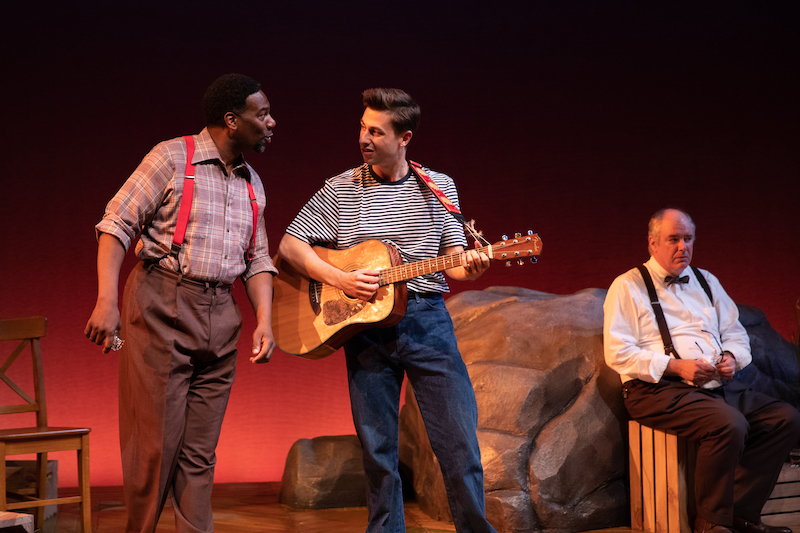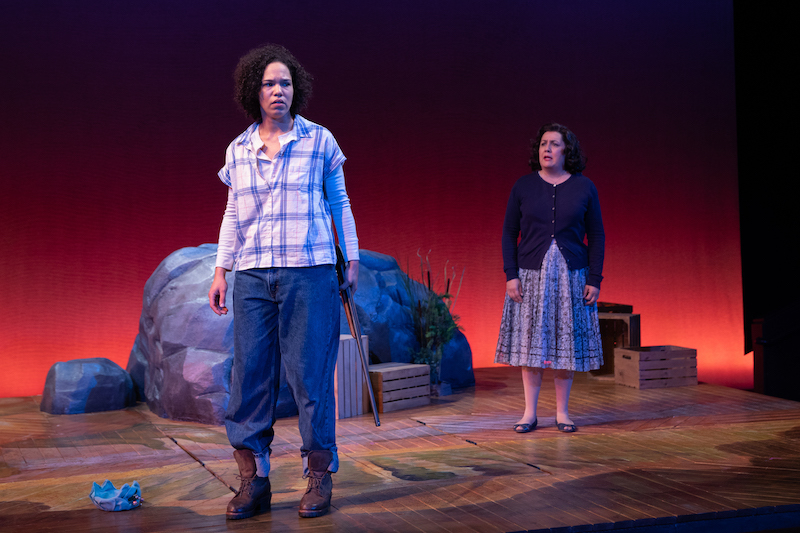Bulrusher: A POC Narrative about Self-Discovery
Review of Bulrusher at Intiman Theatre.
Written by Teen Editor Olivia Sun and edited by Teen Editor Joshua Fernandes.

At seven years old, I thought I knew everything there was to know about living a fulfilling life. For me, the path to happiness was simple: become a famous artist, adopt three dogs, and live in a mansion on the lake. However, I soon realized that life wasn’t as easy as I made it out to be. But with these fanciful dreams no longer clouding my thoughts, there were times when I no longer knew who I was, where I fit into my community, or what I wanted to do with my life. This kind of teenage existential crisis is common amongst my peers, and perhaps this is why playwright Eisa Davis wrote Bulrusher, a coming-of-age story about the pathway to self-discovery.
Bulrusher, set in the year 1955, is a production directed by Valerie Curtis-Newton at the Intiman Theatre. When we first meet Bulrusher (Ayo Tushinde), she is a young woman, living in the small logging and farming town of Boonville. The Boonville residents speak a combination of English and Boontling—an elaborate, esoteric lingo known only by the locals. As an infant, Bulrusher was abandoned in a basket set free along the Navarro River, before eventually being found and raised by an old schoolteacher named Schoolch (Charles Leggett). Eighteen years later, she spends her time running her own orange business, getting schooled by the local brothel owner Madame (Christine Pilar), and being serenaded with love songs by a local teenage boy (Adam Fontana). But as one of just two people of color in Boonville, Bulrusher is a misfit in her traditional, white, working-class rural community. She copes with her struggles of belonging by spending time besides the river that kept her alive as a baby.

One day, however, another young black woman named Vera (Allyson Lee Brown) unexpectedly enters Bulrusher’s life during a visit to her uncle Logger (Reginald André Jackson). As their relationship tightens, Bulrusher’s loneliness begins to fade away, and her thirst for love and family grows stronger. She learns things about Vera’s home back in Birmingham that unveil extreme hardship, but also reveal the tight-knit black community that Bulrusher yearned for. As Bulrusher realizes her needs and values, she grows increasingly independent of her traditional upbringing. This struggle to balance personal desires with societal expectations is something so universal that almost all teenagers, and even adults, have trouble navigating.
To complicate Bulrusher’s life further, she was born with the gift (or curse) of clairvoyance. Reading people’s futures, predicting the weather, and talking to the river are her most impressive abilities, but they’ve also earned her the title of the “Witch” by the townspeople.
These abilities are ironic, considering that she is so blind to her African-American history and has been sheltered from the world outside her rural town. That is, until Vera comes along. Vera, growing up in the city where slavery had thrived and where racial tensions continue to permeate southern society, offers a sophisticated outlook on life. She symbolizes freedom, autonomy, and wisdom. Bulrusher, on the other hand, having only been exposed to her secluded town, possesses a naiveté and innocence that starkly contrasts Vera. Vera describes how her and Bulrusher could not be more different from each other, but also that their differences are what draw them closer together. By the end of the play, Bulrusher has Vera to thank for expanding her horizons.
I wanted to love the Intiman Theatre production from the moment it started, but the first scenes seemed to dwell too long on Madame and Schoolch rather than Bulrusher, the protagonist of the story. Madame is first introduced as a no-nonsense businesswoman with traditional values, while Schoolch is an emotionless man characterized by a constant lifeless, glassy gaze. As for Bulrusher, I tried to empathize with her frustrations and yearning for love and acceptance, but at times, these emotions felt forced. I could only see Bulrusher’s world from afar.

While the first act felt like a bit of a drag, I was captivated by the twists and turns that Davis presented in the second act. As the play unwinds, we discover that Madame’s stern character is a result of her guilt-ridden past: she puts up imaginary walls in fear of her weakness being unveiled. And although Schoolch was compassionate enough to take Bulrusher into his own family, his presence isn’t enough to give Bulrusher the guidance that she needs to find her place. Luckily, Vera becomes the strong mother figure that had been missing in Bulrusher’s upbringing. But as Bulrusher’s friendship with Vera develops, so does her animosity towards her mother who had abandoned her as an infant. The play skillfully employs this element of trust that shapes Bulrusher’s self-confidence.
The dynamic between Bulrusher, Vera, Schoolch, and Madame is eye-opening, but the role of the Boy—-the neighborhood kid in love with Bulrusher—remained an enigma to me. Did Davis use his catcalls to criticize the patronization of women during the 1950’s? Or was he a boy with good intentions—just going through the “young & dumb” phase that so many teenage boys go through? And to add to the ambiguity of the Boy’s relationship with Bulrusher, the play ends with a scene of him finally successfully courting Bulrusher. By ultimately succumbing to the Boy’s pressure, it seems that Bulrusher gives in to the traditional values that she struggled to come to terms with in the first place. Although his love songs and persistent taunts produced a comedic effect, I yearned to know how Davis really envisioned the Boy, and what message he was supposed to communicate.
Friendship, hatred, family, and love—Eisa Davis touches upon them all. Although the 2 hour and 30 minute show may not have been the most enthralling works in the Seattle theater scene, Bulrusher certainly is a work that challenges our conventional assumptions about finding our niche within the complexity of our society.
Lead photo caption: Allyson Lee Brown and Ayo Tushinde in Bulrusher. Photo by Naomi Ishisaka.
The TeenTix Newsroom is a group of teen writers led by the Teen Editorial Staff. For each review, Newsroom writers work individually with a teen editor to polish their writing for publication. The Teen Editorial Staff is made up of 6 teens who curate the review portion of the TeenTix blog. More information about the Teen Editorial Staff can be found HERE.
The TeenTix Press Corps promotes critical thinking, communication, and information literacy through criticism and journalism practice for teens. For more information about the Press Corps program see HERE.

